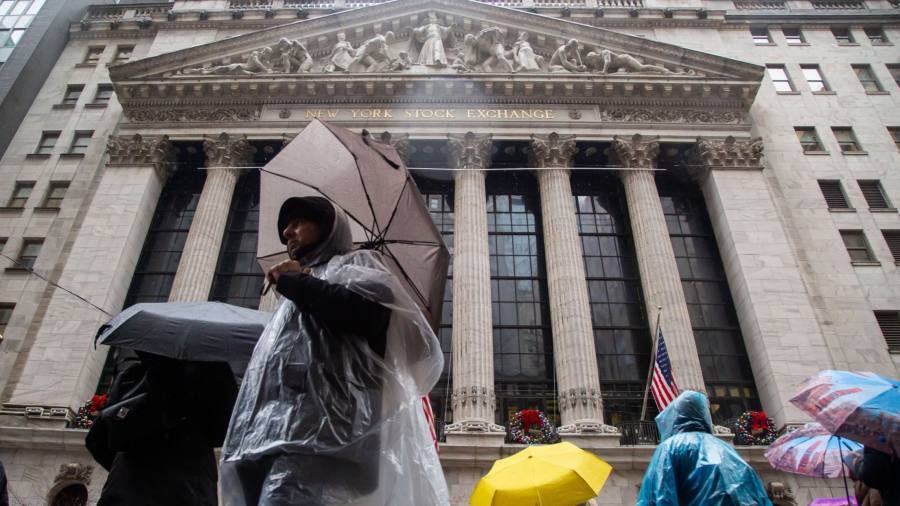Somewhere between bank-run fear-mongering and “maybe AI will save us” wishcasting, one can find slightly more reasoned predictions about stocks this year.
(We’re talking about US large-caps and the S&P 500, of course. Surely you didn’t think we meant UK-listed firms?)
The bad news: The reasonable predictions aren’t especially optimistic. And the outlook for US multinationals’ profits might be worse than Wall Street expects, because one key measure of earnings quality has dropped to its worst level in a quarter century.
Wall Street strategists (who mostly try to figure out which way the macro winds are blowing) expect the S&P 500’s EPS to decline by less than 1 per cent, on average. This type of call is decent career protection in these uncertain times, because “uh . . . flattish?” won’t make investor clients too angry, no matter what happens.
Single-stock analysts expect 1.7 per cent of profit growth for S&P 500 companies this year, according to FactSet. This could also be career protection, as saying “uh . . . good number goes up, but just by a little?” is a good way to keep getting invited to companies’ conferences without embarrassing yourself.
Luckily for us, Morgan Stanley’s equity strategists have stuck their necks out. They are forecasting a nearly 15-per-cent drop in profits from last year, to $185 of earnings per share.
To support their case, they point to a couple of historical comparisons, and most interesting, an earnings-quality metric that is showing its worst reading in a quarter-century.
First they provide some historical context. The strategists have been arguing that Covid-19 lockdowns set economic growth (and corporate profits) down a path of short and sharp swings between expansion and contraction. They think the years after WWII make for a good comparison:
We based this thesis in part on a comparison with the post-WWII period, which looks quite similar to today in many respects. First and foremost, the excess savings built up during WWII/Covid lockdowns were unleashed into the economy at a time when supply was constrained. In each case, both fundamentals and asset prices returned to prior cycle highs at a historically rapid pace.
The boom in inflation and earnings in 2021, which we forecast well in advance, eventually led the Fed to tighten policy at the fastest pace in 40 years. This boom, and Fed reaction, proved surprising to many. Now, we suspect many will be surprised again by the depth of the earnings decline in 2023, as well as the subsequent rebound in 2024-25 — aka the “boom/bust” regime.
Second, they give a historical comparison. Since 1953, the median decline in earnings has been ~16 per cent during a pullback in corporate profitability. So the strategists figure that their estimates for a ~15-per-cent decline, which they attribute to the bank’s “earnings models”, are in line with long-term averages as well:
The 16-per-cent figure is mainly helpful if an earnings contraction does come to pass, however. What’s backing up the idea that earnings really will fall, besides a comparison to, uh, the second world war?
That’s perhaps the most interesting part of their note.
Companies’ profit growth over the past 12-18 months has far outpaced their increase in cash flow, the strategists say, citing work by the bank’s accounting and tax strategy team.
The accounting strategists found that “accruals” — driven in part by inventory build-up — recently climbed to their highest point in at least 25 years for companies in the S&P 1500 (which represents about 90 per cent of all US stocks). From the team’s Sunday note:
If reported earnings keep outpacing cash flows, the market may be over earning. Digging deeper, we found that most of the accruals have been building in working capital, specifically within inventory. Mean reversion suggests these record high levels should gravitate lower, negatively impacting future margins and earnings.
Not great!
As the bank’s equity-strategy team points out, the trend carries across sectors, with energy, industrials and consumer discretionary companies faring worst:
The accounting team compares subsector accruals to their historical averages, which also provides some helpful context:
In other words, food, energy, and consumer durable goods/apparel companies could see the sharpest reversion to the mean, assuming the mean reversion does in fact happen.
The bank’s equity strategists think this will happen as inflation recedes. “Margins and earnings will decline rapidly as inflation falls — so be careful what you wish for,” the bank wrote.
Live by the greedflation, die by the greedflation, we guess.
Read the full article here






